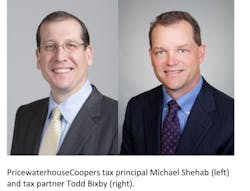The term “tax transformation” is cropping up with increasing frequency these days—for good reason. Tax functions in large and mid-sized companies are contending with a daunting array of challenges related to growing globalization, complexity and organizational data supplies.
What’s more, some staggering regulatory shifts loom on the horizon: Just ask your chief tax executive, who you may have seen wandering the hallways, muttering something that sounds like “BEPS.” Add to these hurdles the same type of resource challenges other back-office functions contend with and some interesting tax-technology breakthroughs—and the notion of tax transformation becomes compelling.
PricewaterhouseCoopers tax principal Michael Shehab and tax partner Todd Bixby recently took some time to detail the nature of this transformation.
What is “tax transformation?”
Shehab: In general, tax transformation is an assessment of the tax function with the objective of creating a more strategic tax department that becomes a more integrated partner within the business and helps contribute actionable insight to the broader organization. In a transformation project, companies evaluate their people, process, technology and data to look for opportunities where changes can lead to benefits not only within the tax function, but for the broader business.
Does this journey have any helpful comparisons or parallels—perhaps the process that corporate finance went through about 10-15 years ago, or what internal audit more recently undertook?
Bixby: Tax transformation is directly analogous to the transformation efforts the corporate finance function has undergone and is still going through. The key difference this time, and with current financial transformation efforts, is that enhancements to ERP functionality, coupled with other technological advances, have made the business case to involve tax much more apparent. There is now consensus and empirical evidence in the market that support tax transformation efforts. More importantly, if there is a finance transformation effort being undertaken, that great efficiencies can be gained by including tax in the process.
What are some of the key capabilities of a leading (or “transformed”) tax department today?
Bixby: Although most tax transformation efforts are multi-year journeys that exhibit maturing capabilities over time, tax departments can expect to see a more integrated end-to-end tax processes, reduction in the size, complexity and number of spreadsheets, more timely access to tax relevant data, and more seamless integration with finance and IT, just to mention a few.
The ability of the tax function to leverage technology and process improvement means less time spent on manual efforts such as data manipulation and document retrieval, and more time spent on strategy, scenario planning and substantive review. Business leaders can make more informed decisions as greater access to data allows for more predictive analytics and forecasting in a more timely fashion.
In addition, the tax function is in a better position to defend historical tax positions and respond more quickly to changes in regulations.
Lastly, the risk of error in the tax compliance and financial reporting processes can be reduced because tax leaders have more time for review and analysis.
What are some of the strongest drivers of the need for tax functions to transform?
Bixby: One does not have to look too much beyond some of the global megatrends that are impacting businesses and their tax functions.
First, with advancements in technology, the tax department can now leverage technology that is readily available within the enterprise or by leveraging the cloud and with reasonable investments can see big gains in efficiency.
Second, with shifting demographics and globalization, tax can benefit by leveraging workflow and document management, to facilitate collaboration, and provide access to data in a virtual work environment to leverage alternative resource models.
Third, in the global economy, with increasingly complex tax regulations across the globe, tax data needs to be more integrated with financial data, sensitized, and consolidated from different parts of the globe in a more seamless fashion. Complexity in the business structure and a move towards emerging markets has further driven the need for forward-looking data analytics and reporting to provide strategic insights and to comply with unsophisticated regulatory regimes.
Tax departments of all sizes, across all industries, face similar challenges, just on different scales. The data necessary to serve the needs of the tax department is often difficult to access and stored in disparate systems and spreadsheets, unsupported by IT. Inadequate investment in technology has meant heavy reliance on complex spreadsheets, creating risk in the compliance and financial reporting processes. In an environment of ever-increasing regulatory pressures, companies need proper reporting to enable planning and analysis, as well as to reduce compliance risk.
What are some of the major impediments to tax transformation?
Bixby: As with most transformation initiatives, establishing a strategy depends on a dedication of resources.
Stakeholders, including members of the tax department, finance/accounting, and IT, must participate and allocate the hours necessary for the task, based on the size and complexity of the organization. They also must understand the current processes and the existing and available technologies required to chart the path forward. Many times this is difficult, as the tax function is often performed in a silo and a cost center, as opposed to a strategic partner in the business.
The tax organization should include a dedicated tax technology role to facilitate and manage its data, reporting and technology needs, and to be the liaison with the finance/accounting and IT organizations. An internal sponsor should also be assigned with ownership and responsibility to communicate the strategy, obtain executive support, and implement the resulting tax technology strategy.
The commitment requires attention to the basic logistics of bringing stakeholders together and, on the technical side, the knowledge of available technologies that could be useful to tax. The tools to be considered include dedicated tax technologies as well as cross-functional technologies including, but not limited to, data warehousing and reporting technologies, and a company’s ERP system.
Finally, once input has been obtained and a strategy has been developed, a proposal for the initially agreed-upon project(s) must be approved by the appropriate individuals, often including an organization’s CFO and CIO. This is another juncture where the involvement of stakeholders outside of tax, in addition to their endorsement, is invaluable.
What about tax talent management—what’s the degree to which finding and keeping tax talent is a current and future challenge?
Shehab: Globalization and changing demographics have put a greater emphasis on attracting and retaining tax resources in different and distant locations. More companies operating in areas with smaller talent pools have exponentially increased competition for top talent. Changing demographics and cultural differences mean that future prospects are looking for incentives beyond compensation to other motivators such as work/life balance and development.
Additionally, many potential employees already have an aptitude for working in different ways and collaboratively with social media technologies and have expectations to be able to use similar technologies to do their work. Demographics will continue to change, so the tax function, and the broader business, must continue to evolve to meet the changing talent needs and models.
What are some important enablers of tax transformation?
Shehab: The key enablers of a successful tax transformation are the same enablers of a successful tax function: people, process, technology and data. Tax function leaders have to understand their data needs and where they are from a process and technology perspective, and also have the vision for how the tax department can be better positioned for success.
Companies should have a plan for how technology can be deployed to meet their tax strategy, and once in place, companies can begin to prioritize each individual investment based on specific aspects of the tax function they are trying to remedy. Placing a focus on the processes you want to automate, the people you want to bring together, and the data you need to make thoughtful business decisions will reduce the amount of time spent on future patchwork solutions and facilitate a successful transformation.
Most importantly, there has to be a commitment from everyone, inside and outside of tax, to making the transformation of tax a priority and an understanding that a well-functioning tax department is vital to the business.
GRC expert Eric Krell supplies the finance community in-depth articles and commentary examining governance, risk and compliance, and has been a regular contributor to IndustryWeek’s sister publication Business Finance for many years. Eric loves his home base of Austin, Texas, as well as reader feedback. He can be contacted at [email protected].




